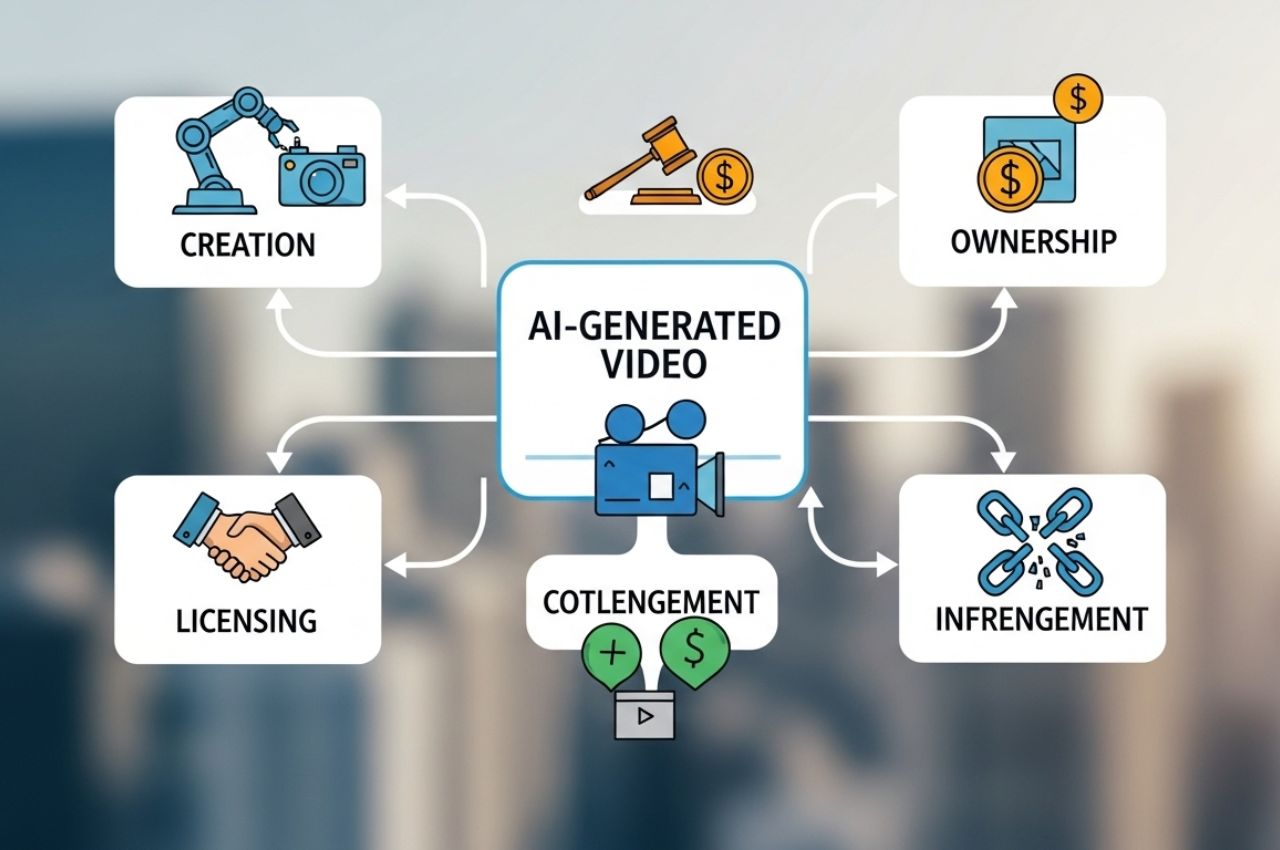AI-generated video copyright rules are among the most debated issues in today’s digital world. With tools that can generate realistic video from text prompts, questions of ownership, originality, and infringement are more important than ever. This article explains how copyright law applies to AI-generated video, who owns the rights, the risks of infringement, and what creators can do to stay legally safe.
Why AI-Generated Video Copyright Rules Matter
The rise of AI-powered video generation tools has blurred the lines between human creators and machines. Unlike traditional works, which have a clear human author, AI-generated outputs may not meet the legal definition of authorship in many jurisdictions. For creators, this means potential challenges in monetizing or protecting AI content. For platforms, it means navigating takedown requests and infringement claims. Governments worldwide are updating policies, but gaps remain.
Current Legal Landscape
In the United States, the U.S. Copyright Office has clarified that works “produced entirely by AI without human input” are not eligible for copyright protection. Courts have echoed this stance, ruling that human creativity must play a role. In contrast, the European Union is considering frameworks that address “computer-assisted works,” where human input guides the creative process.
Other jurisdictions, like the UK, grant copyright in “computer-generated works” but assign authorship to the person making the “arrangements necessary”. This patchwork creates uncertainty, especially for global creators.
For now, the safest assumption is: purely AI-generated videos cannot be copyrighted in many regions, but hybrid works with human input may qualify.
Who Owns AI-Generated Content?
Ownership of AI-generated videos is complex. In most cases:
-
Full AI output: No copyright protection. Anyone could legally reuse the content.
-
Human-guided AI output: May qualify for copyright if the human contribution is significant.
-
Platform terms of service: Some AI tools claim ownership or require users to waive rights.
For example, OpenAI and Runway typically allow users to own outputs generated under paid licenses but restrict certain commercial uses. Creators must carefully read the licensing agreements of their chosen AI tool before publishing or monetizing content.
Key Risks for Creators
Key risks include:
-
Training data issues – If the AI was trained on copyrighted videos, outputs may unintentionally resemble existing works.
-
Lack of protection – Without copyright, creators cannot stop others from reusing their AI-generated videos.
-
Takedowns & disputes – Platforms like YouTube may flag AI content as infringing, even if unintentionally.
-
Ethical backlash – Audiences may criticize AI-created works that appear to exploit existing artists’ styles.
These risks make compliance and transparency essential.
Best Practices to Stay Compliant
Creators can stay safer by:
-
Combining human creativity with AI outputs (scriptwriting, editing, narration).
-
Reading AI tool licensing terms carefully before publishing.
-
Attributing AI involvement where relevant to maintain transparency.
-
Registering hybrid works with copyright offices if human contributions are significant.
-
Avoiding imitation of copyrighted characters or styles without permission.
Following these steps doesn’t guarantee ownership but reduces the risk of disputes.
AI Copyright in Different Countries
-
U.S. – No copyright without human authorship.
-
UK – Allows copyright in computer-generated works, attributed to the person making arrangements.
-
EU – Ongoing discussions; leaning toward human authorship requirement.
-
Japan & China – Exploring flexible models to encourage AI development while protecting rights.
Creators working internationally should adapt to the strictest applicable standard.
Ethical Considerations Beyond the Law
Even if a video is legally permissible, creators face ethical questions:
-
Should AI be used to replicate deceased actors without consent?
-
Is it fair to mimic an artist’s style?
-
How transparent should creators be about AI involvement?
Responsible creators balance innovation with respect for human creativity.
Experience: A Creator’s Case Study
A small YouTube creator experimented with an AI video generator to produce animated short films. Initially, the content gained traction. But when the channel applied for monetization, several videos were flagged due to “unclear copyright ownership.” After reviewing the AI tool’s terms, the creator realized the outputs were not fully owned and had to rework content with more human input.
This experience shows why it’s essential to understand AI-generated video copyright rules before building a content strategy.
Visual Suggestions
-
Infographic: “Who Owns AI-Generated Videos?” – breakdown by country. (Alt text: diagram showing copyright rules across U.S., EU, UK, Asia)
-
Flowchart: “Can You Copyright Your AI Video?” – decision tree. (Alt text: flowchart explaining when AI video qualifies for copyright)
-
Bar chart: Percentage of creators worried about copyright issues in AI (based on surveys). (Alt text: survey chart showing copyright concerns among creators)
-
Illustration: Hybrid creation (human editing + AI footage). (Alt text: concept art of human-AI collaboration in video editing)
FAQ
1. Can I copyright a video made entirely by AI?
In most countries, no. Pure AI-generated content without human authorship does not qualify for copyright protection.
2. What if I edit or narrate over an AI video?
Human input like editing, scripting, or narration may make the work copyrightable. Rules vary by jurisdiction.
3. Who owns AI-generated videos made on a platform?
Usually the user, but platform terms may assign rights differently. Always review the licensing agreement.
4. Can I monetize AI videos on YouTube?
Yes, but YouTube may require proof of original contribution. AI-only videos risk demonetization.
5. Could AI videos get me sued?
Yes, if they infringe on copyrighted material (e.g., characters, footage, styles). Consulting a professional is recommended.
6. Are AI copyright rules the same worldwide?
No. Laws differ across the U.S., UK, EU, and Asia. Global creators must check each region’s regulations.
Conclusion
AI-generated video copyright rules remain unsettled but are rapidly evolving. Creators must combine human creativity with AI, understand platform terms, and stay updated on international law. Doing so helps protect both their work and their reputation. For continued updates on AI, law, and digital creativity, consider subscribing to trusted legal and tech newsletters.

